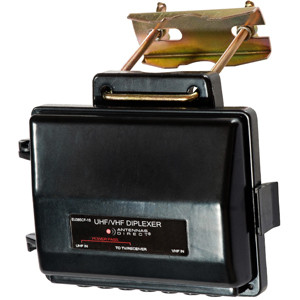That Radio Shack device is a simple splitter that works for VHF-FM-UHF. It won't add VHF and UHF antennas efficiently.
I'm not so sure about that. Here's some old specs taken from an Amazon comment. It also states there is a DC connection on the UHF port.
Copied from An Antennas Tech from St Louis, MO (Antenna Professional, Business Owner, Hobbyist)
The Shack Is Back! Shop Radios, Headphones, TV Antennas, Cables & Adapters, DIY Tools & Parts, Electronics Maker Kits, and much more brand new arrivals daily! Don't forget to visit any of our 450+ RadioShack locations across America!

www.radioshack.com
Comments about RadioShack VHF/UHF Gold-Plated Splitter-Combiner:
This device, 15-2586, as several other reviewers have stated, is for a VERY SPECIFIC PURPOSE. While it "looks" like a regular splitter, it is not and should not be used for that purpose. It is intended SOLELY to either separate or to combine (it is a reciprocal device) two ranges of channels: VHF (below 300 MHz and UHF (above 350 MHZ).
A sample of this device was lab tested and found to have the following attributes:
Rejection 54-300 MHz greater than 35 dB
Rejection 470-1000 MHz greater than 32 db
Insertion loss 54-220 MHz less than 0.5 dB
Insertion loss 470-1000 less than 1.2 dB (average .75)
This device will pass DC power on the UHF port.
The most typical application for this device is to combine separate UHF and VHF antennas.
It is NOT to be used for the following:
Combining antenna and cable or satellite signals.
Splitting antenna, cable, or satellite signals to multiple TV sets or receivers.
In all, a technically good device. Unfortunately, the specifications and descriptions on this web site were written by someone without the technical expertise to explain this device. Hopefully, this will help!
Read less




